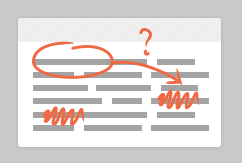About Viooly
Viooly acts like a mirror so we can better “see” how others feel when they read about what we are doing to make the world a better place.
Using Viooly
-
Write
Enter Your Text into Viooly

VIOOLY can process anything from a tweet about the results of a nutrition program in Kansas to a speech about ending global poverty. To begin, on right side of the toolbar, select Create a New Document. Enter a title for your document. If you do not title your document prior to running the analysis, it will be saved as Untitled Document. Use VIOOLY's text editor to draft your content, or simply copy and paste your text into VIOOLY to get started.
-
See
Analyze to Get Results

Select Run Analysis on the right and Natural Language Processing software checks your text for common issues that get in the way of people understanding the effectiveness of development in other countries. VIOOLY highlights your text, showing you what may or may not work well in making your case to audiences. The tool will analyze most materials within 10 seconds. You can see the diagnostic progress with the changing colors for each of the 10 metrics (e.g., Actors).
-
Reflect
Consider Making Edits

VIOOLY's results allow you to see how easy and understandable your text is to read. It can also show you how warm or cold your words are, and what relationships are being conveyed in your story. Based on the results, you can assess making revisions to help clarify and improve your writing. As you make changes to the text, you will also see the results change in real-time.
Save your document at any time to keep your changes.
-
Print and Share
Show Your Impact

Share your results with colleagues by Saving and/or Printing your document. You can easily return to any saved document by accessing My Documents. You can print any document with the four major scores (Readability, Warmth, Power and Overall Score) along with one individual metric (e.g., Reading Ease). This allows you to share the breakdown of your document's analysis with others.
The Challenges
“It’s not what we say, it’s what they hear.”
Contrary to what we read in the papers everyday, we are making strides everyday in improving the lives of others, across a number of different issues. But our messages of success aren’t getting through to audiences.
The number of people living in extreme poverty has been cut in half over the last decade. The education gap in the US is declining as are childhood obesity rates. Yet when asked, many people don’t see the value in government interventions or don’t understand the extent to which progress is being made in the social sector.
The Solutions
Writing is clearly an art, but science can inform the process. Linguistics and neuroscience help explain how people perceive and process what they read and hear. Computer science methods, like Natural Language Processing software, can help you apply these insights in a practical way. Using these strategies, Viooly can quickly assess the complexity and implications of your phrasing choices, while simultaneously showing you opportunities to positively influence your readers’ perceptions.
We know that people aren’t perfect and neither are algorithms, so we expect that you may see some things that don’t quite make sense. If you see something that doesn’t seem right, please let us know. We’re working to make this tool better for you.
About the Developers
Viooly is being developed by GALEWiLL Design, in collaboration with the data visualization firm Periscopic. This project was originally developed to address issues pertaining to foreign aid and development. Much of the research that this tool was based on applies to cause communication in general, and the tool has been modified to reflect this. This project was made by possible by generous grants from the Bill & Melinda Gates Foundation and The New Venture Fund and administered by Third Sector New England.